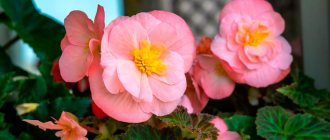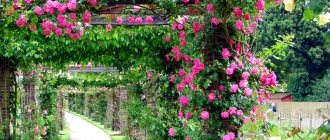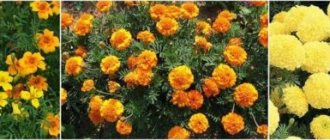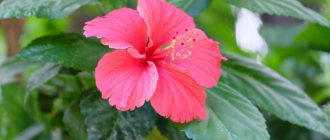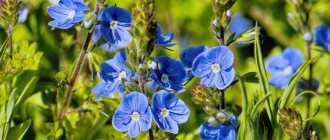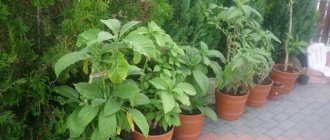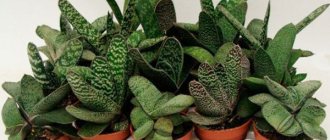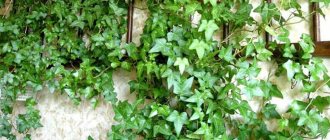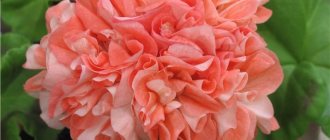It is quite difficult to improve shady places in the garden. The fact is that a relatively small number of crops are known that grow and develop normally in such conditions. If a shady place is located near a large tree, then the soil in such a place, as a rule, is not highly fertile and also has high humidity. To successfully landscape such a place, you need to think carefully. To arrange shady ledges or corners located in the northern part of the garden, it is recommended to use fern, ivy or periwinkle. Such crops feel great even in very dark areas. If you want more variety, then you can look among other shade-tolerant crops, but it is better to choose perennials that are unpretentious to growing conditions.
There are quite a lot of crops that grow well in sunny areas. But you will have to look for shade-loving varieties. At the same time, most species can grow in a partially shaded place with poor sunlight, but the bushes do not bloom so luxuriantly or the foliage becomes faded. Crops planted near shrubs and trees or growing near the northern wall of a building are found in precisely these conditions.
Ferns
Ferns thrive in a shaded area, but they need moderately moist soil. The following types of ferns are most popular among gardeners:
- male shieldweed;
- common millipede;
- the bladder is fragile;
- common ostrich;
- multirow spinous.
Bladder brittle
Common ostrich Common bladderwort
What plants to plant in a shady area
Dracaena
The dragon tree is a popular houseplant native to the tropical regions of Asia and Africa.
Characteristic
It has pointed long and wide leaves, strongly curved back. All leaves grow in a fan pattern and have a yellow center with white or light green stripes. The plant has no visible trunk and rarely blooms indoors. Perfect for decorating an office or bedroom.
Feels good in dark and semi-dark rooms. To successfully grow dracaena, it is necessary to provide it with suitable temperature conditions - the room should be at least +20˚C. Otherwise, it loses its decorative properties, the leaves become less bright, and the ends gradually begin to dry out.
Features of planting and care
Dracaena is a heat-loving plant, but when the temperature rises above 30˚C, the leaves sharply bend down, and at temperatures below 16˚C, growth slows down. Dracaena requires moderately moist soil. Warm water should be used for irrigation.
The soil should be slightly acidic and fertile. You can use soil for palm trees, but add drainage. The plant loves spraying and wet treatment of leaves. Replant when the roots are well established. Dracaena propagates through head cuttings rooted in water or special soil.
Sod plants
Below we will describe in detail perennial ground cover plants that cover the ground and are shade-tolerant.
European hoofweed, ivy and periwinkle
European hoofweed Common ivy
Periwinkle
Ivy, Common Periwinkle and European Clefthoof do not need much light to grow properly. Nutritious soil with high humidity is best suited for growing them, but they can grow in worse conditions. Such crops, even when grown in a shady place, grow and develop within normal limits.
Creeping tenacious
Such a perennial plant as creeping tenacious grows in large groups. It forms creeping shoots under the soil surface, which is why it is often used to protect the soil from landslides. The tenacious plant grows well in shade.
During flowering, the bush is decorated with small blue flowers, which are part of the spike-shaped inflorescence. Flowering occurs in May–August. Varieties with reddish-brown foliage are often grown in gardens.
Fragrant bedstraw
The shade-tolerant fragrant bedstraw blooms in April, and flowering ends in June. Its small flowers are collected in cluster-shaped inflorescences. Bedstraw has an aroma similar to hay.
Pachysandra apex
Such an evergreen plant as pachysandra apex is also called Japanese milk. Flowering is observed in May, and the flowers do not have any decorative value. This shade-loving crop can be used to improve the area under trees. The bushes grow strongly, covering the ground with a beautiful green carpet.
Spleen
Belonging to the Saxifraga family, the shade-tolerant spleen has both perennial and annual varieties. This culture received such an unusual name because it is used for diseases of the spleen. Perennial varieties prefer to grow in moist soil. Their shoots are decorated with evergreen leaf blades that are leathery to the touch. Flowering is observed in May; small star-shaped flowers appear on the bush. They are painted white, with a red central part. The flowers are part of loose panicle-shaped inflorescences.
Saxifraga shadow
Perennial saxifrage shady has a small compact bush. It often forms a rather extensive turf that does not bloom. This plant is most widespread in the Northern Hemisphere. Lush inflorescences consist of small pink flowers. This flower prefers to grow in partial shade, and nutritious and moist soil is most suitable for it. Saxifraga can form dense, extensive thickets that are highly decorative.
Plants for shade and partial shade. Shady garden
How to care for shade-tolerant plants?
A flower garden created in the shade requires a special approach. To achieve lush greenery and abundant flowering, the usual care measures are carried out, but the emphasis is different:
- Many plants growing in the shade love moisture; they may often lack it, especially in hot weather. During this period, it is necessary to provide them with watering, without waiting for the leaves to wither.
- All plants, except wild ones, need feeding. If there is insufficient lighting, nitrogen fertilizers should be used carefully, otherwise an excess of them can cause thickening and stretching of plants.
- The soil also needs to be prepared for creating a shade-loving flower garden. If it is loam, then you can lighten it by adding sand and peat. In loose soil, it will be much easier for shade-tolerant plants to absorb moisture, because many of these species have shallow roots.
- To avoid infection with various diseases and parasites that love dark and damp places, do not allow the development of weeds, accumulation of debris, and do not thicken the plantings. Feed with phosphorus and potassium to increase plant immunity.
Shade-tolerant plants can be a real gift for the gardener - they can be grown without putting in excessive effort, and they are often even more beautiful than all other plantings. A rich variety of species makes it possible to choose something that best suits the taste or style of your garden.
Herbs that tolerate shade well
In shaded areas, some herbaceous crops do quite well. Shade-loving herbs will be described in more detail below.
Ozhika forest and snow
Ozhika snowy
Ozhika forest and snowy is a perennial shade-tolerant plant that is quite popular among gardeners. It is often planted under bushes or trees. However, the hedgehog may die if it remains in deep shadow all the time.
Ozhika forest
Forest grass is an evergreen plant whose foliage is covered with long hairs.
Fescue
Swamp fescue, or gray fescue, or low sedge is a semi-evergreen or evergreen perennial plant belonging to the Poaceae family. It grows well in shaded areas.
Begonia
Indoor shade-tolerant plants, which include numerous varieties of domestic begonia, will decorate your home with a bright bouquet of flowers: yellow, red, white, orange and pink.
Names and photos can be seen on gardening forums. Flowering time - depending on the variety - all year round. They develop well at temperatures from +15 to +20˚С.
Characteristic
A flower of the begonia family with bright and colorful blooms, it does not need an abundance of sunlight. It grows well in dark corners of the apartment. When receiving excessive sunlight, the leaves and inflorescences become brown.
Features of planting and care
Begonias prefer acidic, nutrient-rich soil, preferably with a gravel or sand bottom that drains. Feeding is carried out every 2-3 weeks. In those months when the plant rests, in autumn and winter, fertilizers are not introduced. Begonia does not like waterlogging.
Plant experts recommend replanting begonias every 1-2 years. Indoor varieties do not need pruning, but for abundant flowering it is necessary to regularly remove dead shoots.
Low shade-loving perennials
Fragrant violet
Garden plots are often decorated with shade-tolerant fragrant violets. Its small purple-blue flowers have a very pleasant aroma. The plant is unpretentious and spreads quickly. Flowering is observed in March–May. When planting violets, you need to remember that it spreads very quickly throughout the area and can easily occupy an area not intended for it.
Lungwort
The height of the red lungwort is about 0.3–0.4 m. Flowering is observed from March to May, at which time the bushes are decorated with small red-brick flowers. The crop can be planted under shrubs or trees.
Sugar lungwort
Sugar lungwort is grown in shade and partial shade. She prefers nutritious soil with high humidity. Its dark green, showy leaf blades have specks of a contrasting silvery-white hue. When formed, the flowers have a red-coral tint. But when they open, their color changes to blue, pink or purple. Flowering - in March–April. This lungwort forms lush and dense bushes that cover the soil.
Noble liverwort
Liverwort is an evergreen herbaceous plant. It forms low carpets. In favorable conditions, the foliage remains throughout the winter period: in the upper part the plate is green, and in the lower part it is light yellow. Liverwort is often planted under tall trees to create a green carpet.
Lily of the valley
Lilies of the valley prefer to grow in shady areas. Their reproduction occurs by rhizomes. However, in dense shade, lily of the valley blooms sparingly, but the foliage grows well. To plant this crop, you need to choose a place that will be in the shade for at least half the day. The bushes are decorated with small bell-shaped flowers with a characteristic scent.
Garden hellebore
Garden hellebore is one of the first to bloom with the onset of spring in the garden. If the winter period is relatively warm, the flowers may bloom as early as December. This plant is planted in shady areas, and the chosen place should be secluded and with high humidity.
Doronicum eastern
Doronicum orientalis blooms in May, and the bush is decorated with yellow-golden flowers. Loose garden soil with high humidity is best suited for it. It is recommended to choose not too dark areas for planting that are in partial shade.
Primrose fine-toothed
The shade-tolerant fine-toothed primrose does not grow well in sunny areas and may even die. A slightly shaded area is perfect for it. The soil chosen is loamy, neutral and nutritious, but it must be constantly moist (even in summer).
What to Plant in the Shade
